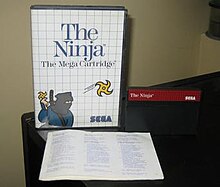Sega Ninja: Difference between revisions
SNAAAAKE!! (talk | contribs) mNo edit summary |
SNAAAAKE!! (talk | contribs) No edit summary |
||
| Line 41: | Line 41: | ||
[[Category:Sega System 1 games]] |
[[Category:Sega System 1 games]] |
||
[[Category:Ninja video games]] |
[[Category:Ninja video games]] |
||
[[Category:Video games featuring female protagonists] |
|||
Revision as of 21:23, 11 September 2013
| Sega Ninja | |
|---|---|
| Sega Ninja | |
| Developer(s) | Sega |
| Publisher(s) | Sega |
| Designer(s) | Rieko Kodama |
| Release | 1985 |
| Genre(s) | Run and gun |
| Mode(s) | Up to 2 players, alternating turns |
| Arcade system | Sega System 1[1] |
Sega Ninja (known as Ninja Princess (忍者プリンセス) in Japan) is a 1985 arcade game released by Sega. The game features Princess Kurumi (くるみ姫 Kurumi-Hime), the titular female ninja, battling enemies using throwing knives and throwing stars.[2]
Plot and gameplay

The game is set during Japan's Edo era, in about the year 1630, in a province called Ohkami in the western region, where the power has been seized by an evil tyrant Gyokuro. The goal is to end his oppressive rule and restore peace.
Gameplay is typical of a run and gun game, such as Commando and Ikari Warriors,[3] where the player has to shoot enemies and defeat a boss.
Enemies include samurai, ninja and dogs. The player's normal weapons are an unlimited supply of throwing knives, but power-ups to throwing stars are available. In addition, the player can also turn invisible for a short period of time. While most of the stages are vertically scrolling, a few of the levels add some variety - including a level where the player must scale a wall.[2][3]
Home versions

Ports of the game were released for Sega's SG-1000 and Master System consoles.
The latter version, retitled The Ninja, was released a year after the arcade game and changed the protagonist from female to male.[3] Other changes include the rearranging of stages from the original Japanese release in western releases of the game as well as a scroll system, which requires that five green scrolls must be collected to get to final level of the game, as all of them give hints on how the final level must be entered. If the player finishes the game without them, the game will backtrack to a level closest to where a missing scroll lies.[4] Graphics are also different, made in a more realistic style.
References
- ^ a b "System 1 hardware (Sega)". Retrieved 2006-06-18.
- ^ a b "Sega Ninja/Ninja Princess". Emulation Status. Retrieved 2006-06-18.
- ^ a b c Ninjas in Games | An evolution of ninjas in video games throughout the years., UGO.com, June 4, 2008
- ^ "Sega Ninja". Coin-Op Museum. Retrieved 2006-06-18.
[[Category:Video games featuring female protagonists]